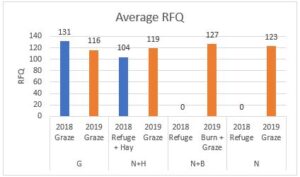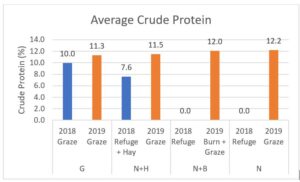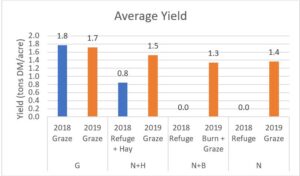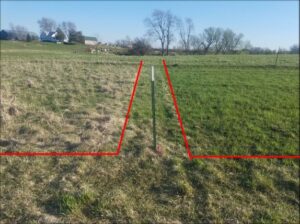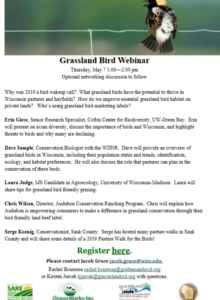Final report for GNC19-279
Project Information
Ground-nesting grassland birds have experienced steep declines in population over the past several decades, concurrent with the conversion of the Midwestern landscape to intensive, row-crop agriculture. With nearly all native grasslands eliminated, the existing perennial ‘working grasslands’ are extremely valuable as nesting habitat for grassland bird species, many of which are Species of Management Concern. While leaving a portion of pasture ungrazed during the nesting season is known to improve grassland bird reproductive success, this represents sacrificed productivity to a grass-based livestock farmer and little is currently know about the tradeoffs to the farmer or strategies to reduce economic losses. ‘Bird-friendly’ management of pastures is uncommon due to both a lack of producer knowledge about the importance of working grasslands as nesting habitat and, of critical importance, the loss of quality forage. This proposal, titled Evaluating and mitigating forage losses associated with a rest paddock for ground-nesting birds in pastures, will raise both awareness about the importance of pastures as grassland habitat and producer knowledge about ‘bird-friendly’ grazing practices, as well as quantify forage and economic loss during the nesting season. It also explores mowing and spring prescribed fire as potential loss mitigation techniques. Results and recommendations generated will reach a wide audience including grass-based farmers, conservation and grazing professionals, and consumers. The ultimate goal of this proposal is to increase the conservation value of working grasslands through the adoption of bird-friendly grazing practices while maintaining or improving farm profits.
The intended learning outcomes for grass-based livestock farmers and grazing and conservation professionals include increased knowledge of the value of pastures to wildlife and increased awareness of the benefits of the rest paddock practice (and other bird-friendly practices). It will also allow informed decision-making by farmers and professionals by providing data on actual forage production, forage quality, and economic output and offering potential strategies to mitigate losses. Furthermore, depending on results, it could also change the perception of economic losses when using this practice. The ultimate action outcome for farmers is adoption of the rest paddock practice on their grazed lands and a resulting increase in grassland bird reproductive success.
Intended learning outcomes for consumers are similar to those mentioned above. The action outcome is that consumers seek out bird-friendly, grass-based animal products in the marketplace and even accept higher prices for such products. An increasing demand for these products simultaneous with increased supply will ensure the sustainability of these changes in grazing management and continued adoption by new farmers.
The learning outcomes are short-term goals and can be evaluated through post-presentation surveys. The action outcomes are long-term goals and the ability to assess progress toward them is beyond the timeframe of this proposal.
Cooperators
- (Educator and Researcher)
Research
In order to investigate the loss of forage quantity and quality when setting aside land for a nesting refuge, we partnered with a beef farm that seasonally grazed approximately 22 cows, three yearlings and 14 calves on cool-season pasture dominated by Kentucky bluegrass, timothy and orchardgrass (determined by point-intercept method, 40 points on 2 line transects per plot). We also wanted to test whether unharvested forages in the nesting refuge might suppress growth the following season when the refuge was returned to the farm’s typical grazing rotation, so we used two management strategies to harvest or remove built-up plant material: hay harvest and burning. Plots were established (50 ft x 50 ft) and treatments randomly assigned within three replicated blocks. Due to constraints on time and personnel, we were unable to replicate this study at a second location in Wisconsin, as originally planned. Treatments are outlined in Table 1.
|
|
Control |
Nesting Refuge Treatments |
||
|
Treatment |
G |
N |
N + H |
N + B |
|
2018 |
Graze |
Nesting refuge |
Nesting refuge, then hay Aug. 1 |
Nesting refuge |
|
2019 |
Graze |
Graze |
Graze |
Spring burn, then graze |
Table 1. Four treatments replicated three times over two years in a cool-season grass pasture.
In 2018, treatments were either unharvested nesting refuges the entire year (N, N + B) or unharvested until August 1st (N + H). The control plots were rotationally grazed (G) with grazing events in June, August and October. In 2019, N + B treatments that were unharvested in 2018 were burned at the beginning of April. All plots were returned to normal grazing rotations in 2019, with grazing events in July, August and September. Paddocks were grazed when the farmer determined readiness by visual evaluation and cattle were moved out of the paddock when forage heights reached four to eight inches. This resulted in grazing intervals as short as four hours and long as 24 hours for each of the three paddocks containing the replicated blocks.
Available forage was measured before each grazing event (and prior to hay harvest in N + H) by clipping plants within a ¼ meter squared quadrat to a height of four inches. Samples were dried and weighed, then ground and analyzed using Near Infrared Reflectance Spectroscopy to determine forage quality. Relative forage quality (RFQ)—an index that combines various measures of forage quality—was calculated for G and N + H in 2018, and all treatments in 2019. Percent crude protein—an important component of forage quality—was also measured, as well as season-long forage yield in tons of dry matter per acre.
In the spring of both years, data on vegetation height density (using a Robel pole) and litter depth (using standard metric ruler) were collected during the nesting season in order to characterize the habitat created by different management practices and link it to grassland birds species known to prefer those habitat characteristics.
Results
Figure 1. Average relative forage quality (RFQ) for 2018 and 2019 grazing seasons for each treatment
Figure 2. Average crude protein (%) for 2018 and 2019 grazing seasons for each treatment
Figure 3. Average season-long yield (tons of dry matter/acre) for 2018 and 2019 grazing seasons for each treatment
In 2018, establishing an unharvested nesting refuge followed by an August 1st hay harvest resulted in a 55% reduction in forage yield compared to normal grazing (figure 3). Additionally, the harvested hay had an RFQ 21% lower and crude protein level 24% lower than an average grazing event in that year (figures 1 & 2). The monetary loss associated with these reductions can be roughly characterized using hay grades and prices. University of Wisconsin Extension (Hay Market Report, May 25, 2020) categorizes the RFQ of the grazed treatment as Grade 1 hay valued at $159/ton (large square bale). The hay harvested following the refuge treatment was in the Grade 2 category valued at $132/ton (large square bale). Considered together, results indicate a moderate loss in income due to reduced forage quality and a major loss in income due to forage yield (55% loss) on land in the nesting refuge.
In 2019, when all plots were returned to normal grazing management, minimal variability was observed. Plots that were in nesting refuge in 2018 and spring burned in 2019 had the highest average RFQ at 127 and normal grazing (both years) plots had the lowest RFQ at 116 (figure 1). Similarly, plots in nesting refuge in 2018 had the highest crude protein at 12.2% and normal grazing (both years) plots had the lowest at 11.3% (figure 2). While statistical tests could not be performed on these measures due to variability inherent to NIR forage analysis, the range of values does not indicate large variability among treatments or reductions in forage quality compared to normal grazing and may even suggest forage quality trended higher in the refuge treatments. Additionally, statistical tests of forage yield indicated no differences between treatments. Plots in nesting refuge in 2018 and spring burned in 2019 had the lowest yield at 1.3 tons of dry matter/acre and normal grazing (both years) plots had the highest yield at 1.7 tons of dry matter/acre (figure 3).
These results suggest that there are no losses in forage quantity or quality when pasture area is returned to normal grazing the season following a nesting refuge. While researchers did visually observe differences between treatments in early spring, such as higher quality and lower quantity of forages in spring-burned plots compared to unharvested nesting refuges (Picture 1), plots were visually similar when grazing and forage measurements began in early July. Therefore, grazing earlier in the season may yield different results than those shown here. Additionally, both growing seasons (April through the end of August) studied were wetter than normal (based on the 30-year average of precipitation) with 2018 precipitation 37% higher and 2019 13% higher than normal.
Analysis of the plant community data indicated that spring burning promoted growth of red clover (Trifolium pratense). Cover of red clover was 0% in all treatments except the spring burn treatment, which had 9% cover.
Picture 1. Taken April 24, 2019. Both plots were unharvested in 2018. The plot on the right was burned one month prior (N + B).
Discussion
Implications for farmers
This study only captures the effects of these management scenarios on one farm, and additional experiments should be performed across the state. Nevertheless, the 2018 results highlight that the loss to a farmer when setting aside land for a nesting refuge can be significant.
The 2019 results indicate that, in this case, there was no legacy effect of the previous season’s management on forage yield and quality when the land was returned to normal grazing after a nesting refuge season. This suggests that the loss incurred by the farmer only happens on the unharvested land in a designated nesting refuge in that year. That same land returns to normal productivity the following year. Further studies should be done to verify this result in different years and environments.
Implications for birds
Previous research on grassland birds suggests different species prefer different habitat characteristics (for example, high or low vegetation height and density, or shallow or deep litter). In this study, the researchers sought to determine which species might respond to managing pastures with nesting refuges. While actual use of the nesting refuges by bird species was not measured in the study, inferences about the suitability of the habitat were made from measurements of vegetation height and density and litter depth and cover. Measurements taken in the spring in 2018 indicate that a nesting season refuge of an appropriate size could provide habitat for species that prefer medium vegetation height, density and litter layer, such as eastern meadowlark and bobolink. These results are in line with other research on grassland birds, which shows that certain species prefer pastures and hayfields as habitat.
Implications for policy-makers
These results highlight the opportunity to help slow or reverse the decline in numbers of these grassland bird species though altering pasture and hayfield management. While direct and cost-share payments to farmers for conservation practices already exist through government agencies and conservation organizations, none fully compensate farmers for direct losses associated with a nesting refuge. These results could be used as a starting point for determining appropriate compensation levels for farmers setting aside land for a nesting refuge. These payments could be calculated based on the farm’s average income per acre or using current hay prices and on-farm measurements of forage yield and quality. Providing appropriate compensation through conservation funding is likely a key component of improving grassland bird nest success in pastures and hayfields in Wisconsin.
Educational & Outreach Activities
Participation Summary:
On January 6, 2020 I presented the findings from this study to a mixed audience of farmers and agricultural professionals at the American Forage and Grassland Council conference in Greenville, South Carolina. The 15-minute presentation was titled 'Fostering grassland birds on our working grasslands.' The results indicated that nesting refuges in pastures and hayfields do not negatively impact forage productivity the following year, which would have been a major concern for this audience. I also raised awareness of the habitat needs of grassland birds and why the issue of nest success on working grasslands deserves attention.
On January 24, 2020 I co-presented to a mixed audience of farmers, agricultural professionals, and conservation professionals interested in grazing at the GrassWorks conference in Wisconsin Dells, WI. The hour-long presentation was titled 'From bobolink to bumblebees: fostering wildlife on the grazing farm' and was co-presented with an individual who is both an entomologist and a farmer. Given this suite of expertise, we were able to cover the topic of habitat for pollinating insects on the farm as well as habitat for grassland birds and could so do from the perspective of science/academics and the perspective of a farmer. My presentation of research findings was similar to the description above, though given the additional time available I was able to provide more depth on how and why, and also make the case for the critical role of financial incentives to promote the adoption of the practices discussed. Post-session survey results indicated that 10 out of 23 respondents gave it the highest possible rating of 'so helpful I want more,' 11 out of 23 found it 'very helpful' or 'helpful' and only 2 found it 'not helpful.'
I created a 1-page fact-sheet with simple, practical tips to help farmers implement grassland bird-friendly grazing (Bird_friendly_grazing_tips) It is meant to be useful and accessible to grazing professionals, conservation professionals who work with grazing, and farmers. GrassWorks (a Wisconsin-based non-profit that promotes grazing) recently formed an Ask-a-Grazier Google Group and Facebook Group. This fact sheet was sent out to the Google Group and posted to the Facebook Group on March 24, 2020. It received 80 views on Facebook over the following 2 days. To my knowledge, everyone in the state-wide working group of grazing professionals, called the G-team, is a part of the Google group and/or Facebook group, so this resource reached both grazing professionals and farmers. In June, it was also shared with several conservation professionals at the Department of Natural Resources.
On May 7, 2020, Grassworks sponsored a webinar on the topic of Grassland Birds. Two presenters talked about the importance of bird conservation, bird species diversity, and the basic biology of some grassland bird species. I then presented several 'tips' for grassland bird-friendly grazing. The next presenter from Audobon talked about the market-based approach they're working on (bird-friendly beef product label), that will hopefully soon be available in Wisconsin. Lastly, a grazing professional discussed a successful birding-focused pasture walk he hosted last year. Over 100 people attended this webinar.
Lastly, a Research Brief (a non-academic audience friendly style of scientific writing) is close to being published with University of Wisconsin's Center for Integrated Agricultural Systems. This summarizes the project and provides data on the loss in forage quantity and quality and ends with implications for farmers, grassland birds, and policy-makers.
Project Outcomes
This research has inspired excitement for grassland bird conservation in Wisconsin, especially among grass-based farmers, and contributes to sustainability by shifting the agricultural production mindset from linear (inputs to outputs) to interconnected and cyclic, ie viewing the farm as an ecosystem. For example, farmers who begin to notice and actively benefit grassland birds though management may notice increased fly control provided by birds. They also may recognize that their pastures are also habitat, and have value beyond their agricultural production.
The soon-to-be-published Research Brief is designed to push conservation organizations and policy-makers to provide more funding for nesting refuges on farms. This outcome will provide economic benefit to farmers, as well as environmental and social benefits by increasing the biodiversity of rural areas. This will benefit both rural communities and urban-dwellers who visit rural areas and take the opportunity to bird-watch.
The increased awareness and anticipation of the arrival of Audobon's 'bird-friendly beef' label in Wisconsin will also benefit grass-based farmer's economic futures as well.
During the course of this project, my advisor and I gained a fuller appreciation for 2 things: the large scale of working grasslands (pastures and hayfields) in the state of Wisconsin compared to conservation and recreation-focused grasslands, and the importance of how these working grasslands are managed. We were glad to see that none of the nesting refuge treatments resulted in lower forage quantity or quality the following season and a little disheartened to see that the forages losses in the nesting refuge in that year were substantial and that hay harvest and spring burning did little to make up for the losses. This led to recognition of the critical importance for conservation funding to support this practice, as well as market-based solutions to allow producers to make up for losses.
Similar future studies could be performed to measure losses in other locations, years, and environments with the purpose of validating these results. I would recommend focusing on the forage quantity and quality measurements (and leave out the plant composition because prescribed fire was the only treatment that impacted the plant community) in the year of the nesting refuge and the following year. Additionally, I would leave out the spring burn treatment and add in an early spring graze (before April 25th) treatment alone and in combination with August 1st hay harvest. I might also add a late fall graze event to the August 1st hay treatment. These are the most likely scenarios on a typical farm when incorporating a nesting refuge.
Information Products
- Tips for bird-friendly grazing (Fact Sheet)
